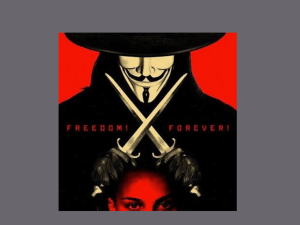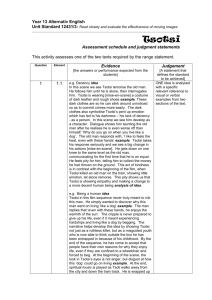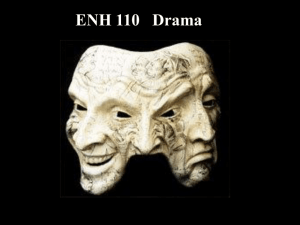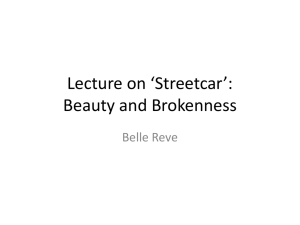La Haine
advertisement
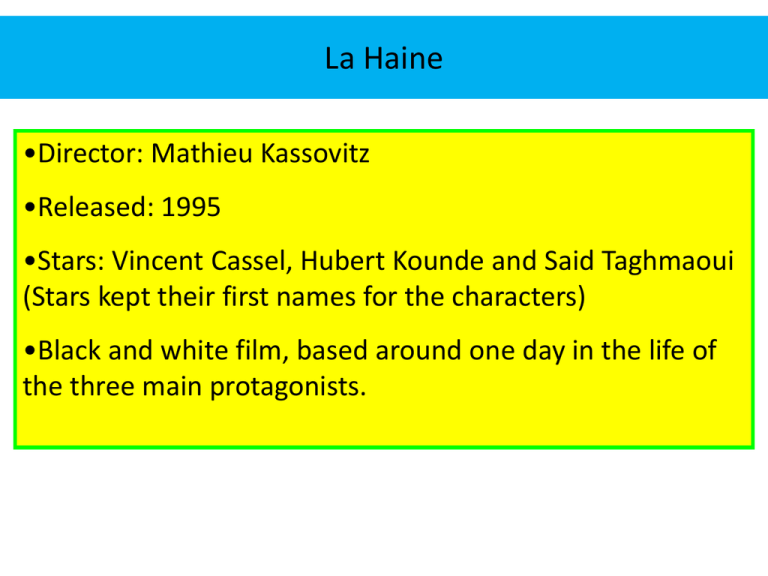
La Haine •Director: Mathieu Kassovitz •Released: 1995 •Stars: Vincent Cassel, Hubert Kounde and Said Taghmaoui (Stars kept their first names for the characters) •Black and white film, based around one day in the life of the three main protagonists. La Haine: Plot and context •The film looks at a single day in the life of three friends, from immigrant families living in a impoverished multiethnic French housing project called a ZUP (zone a urbaniser en prioritie). •The ZUP is in the suburbs of Paris, showing an aftermath of a riot, which helps to highlight the bad relationship between the police and the youth culture occupying the ZUP. La Haine: Plot and context •The film is based on true events in the 1990’s, when social problems in France led to 10 straight nights of rioting throughout the country. •These main reasons for the rioting were excessive unemployment, inadequate housing, poor schooling and unresponsive political structure. La Haine: Characters How would you differentiate between the three main characters? Ethnic Origins Hubert: Black African-French Vinz: From a Jewish Background Said: Arab African- French Ethnic Origins •Drawn together by their shared youth culture, their difference in ethnic origin seems unimportant to them: But each character is shown to be very aware of the ways in which others in France might look at his ethnicity. •For example, because he is ‘white’, it is Vinz who is given the task of attempting to gain entry to the middle-class block of flats where they hope to meet ‘Asterix’. Ethnic Origins What other ways could you differentiate between the three main characters? Discuss the above question in pairs. Make sure you can refer to specific scenes in order to illustrate your point. Key Scenes: Opening scene The opening scene to the film is accompanied by the Bob Marley song ‘Burnin and lootin’, which suggests a particular way of seeing the documentary footage. Watch the opening scene again and think about the ways the lyrics to the song compliment the footage you are watching. La Haine (English subtitles) - part 1/7 - YouTube Key Scenes: Opening scene ‘This morning I woke up in a curfew; O God, I was a prisoner, too - yeah! Could not recognize the faces standing over me; They were all dressed in uniforms of brutality.’ •The first verse of the song relates to how the three main characters may feel living in the ZUP. •It also reflects the attitudes that the three main characters have towards the police. The storyline explores the bad attitude that the people living in the ZUP towards the police and Vice versa. Key Scenes: Opening scene Marley is strongly associated with radical politics and willingness to confront state authorities that are seen both within the music and the associated youth culture as being repressive. As a result the actions of rioters seem to receive a form of endorsement that might not have been achieved had a different choice of musical accompaniment been made. Do you agree? Discuss in pairs. Key Scenes: Interview attempt When the TV news crew are attempting to interview the three main protagonists about the previous nights riot, they literally ‘look down on’ the three friends. What does this suggest about how they are viewed within society? Why do you think the news crew approached them? Key Scenes: Hubert's Bedroom During the scene in Hubert's bedroom, we are met with some iconic pictures that hang on his wall. Firstly a picture of Muhammad Ali, and also African American sprinters Tommie Smith and John Carlos giving the black power salute at the 1968 Olympics. What does this suggest about his character? LO 1:Be able to communicate detailed and relevant understanding of the film ‘La Haine’. LO 2: Create well sustained arguments linked to the context of ‘La Haine’. Key Scenes: DJ scene The DJ using his decks to blast out an anti-police message in a scene which is filmed and edited in such a way as to convey the sense of momentary freedom, escape or release. Why do you think it was important to include this scene? Key Scenes: Toilet scene The three central characters experiencing a surreal storytelling experience with an older man in a Parisian toilet. What is the purpose/significance of this scene? Key Scenes: Final scene The final dramatic scene in which there is a central change to the story that has been retold several times, so that it becomes a ‘society’ that is ‘falling’. What was the significance of ‘Vinz’ dying in this scene? What was Hubert’s purpose within this scene? Why was the purpose of last shot being a close up of Said? Messages and Values •La Haine was based on an actual event; the death of an 18 year old youth shot during interrogation by the police in 1992. • This context gives the central concern for the film, but the riots and the violent confrontation between the police and the young people is placed within a much wider social context. Messages and Values •Multiculturalism and ethnicity within modern French society is clearly explored throughout the film. Examples of this are the posters in Hubert’s room and the song ‘burnin and lootin’, which links directly to ideas of black uprisings. •A positive outlook is that the three friends are all of mixed ethnicity and within the youth culture the separate ethnicities are shown as evolving into a vibrant hybrid of cultural fusion and unity. City of god: Context and plot Directors: Fernando Mierelles and Catia Lund Year of release: 2002 Stars: Alexandre Rodrigez, Matheus Nachtergaele and Leandro Firmino All the characters existed in reality, and the story is based on real events. City of god: Plot and context • It depicts the growth of organized crime in the Cidade de Deus (City of god) suburb of Rio de Janeiro, between the end of the '60s and the beginning of the '80s, with the closure of the film depicting the war between the drug dealer Li'l Zé and criminal Knockout Ned. • The tagline is "If you run the beast catches, if you stay the beast eats,“ Which is a theme that runs throughout the film. The idea that if you are born into the city of god, you are expected to stay and become a hood. (This is an idea that is also explored with the film La Haine and Tsotsi). City of God: Plot and context • The cast includes Alexandre Rodrigues, Leandro Firmino da Hora, Jonathan Haagensen, Douglas Silva, Alice Braga and Seu Jorge. Most of the actors were, in fact, residents of ghettos such as Vidigal and the Cidade de Deus (City of god) itself. • What is the advantage of having actors who are from the Ghetto’s of Rio De Janeiro? • Do you think that this gives City of God an advantage over the other two films watched? Key scenes: Opening scene • The opening to the film focuses on a chicken and its attempt to escape the violent death that is almost inevitably awaits it. • The images that flash up within the scene are of blood and instruments of death, which also help to suggest that the chicken is going to be killed by the group chasing it. • The scene is also accompanied by piercing and threatening sounds, which add a almost tense atmosphere as the chicken is desperate to escape the chase. Key scenes: Opening scene • The chicken trying to escape can be seen as a representation of some of the ‘hood’s’ living in the ghetto. • The chicken is then replaced with the character Rocket, who is then stuck between two equally threatening parties (the hoods and the police), representing him as a character who wants to escape from the lifestyle associated with being a hood. • The opening scene is taken from a scene at the end of the story, but is used as a point for all the previous stories of the slums to amount to. • This shows that this scene is key to the story of ‘city of god’ and is almost seen as the make or break moment for Rocket- should he take his opportunity to be a photographer or join Lil Ze’s gang? Key scenes: Benny’s death One of the pivotal moments within the film is when Benny is killed at the club. Make a spider diagram of reasons why this scene is so important, using examples. Benny’s death Benny is seen as a ‘cool hood’, people are now worried about who is now going to keep the peace. Deaths Deaths also play an important role within the film and are often used in pivotal ways that may change the course of the film. Choose three deaths, other than Benny’s, and create a mind map for each explaining there significance within the film. Consider how the Mise-enscene, cinematography and sound used within the shots are used to create meaning. Other key scenes Other than the opening scene and Benny’s death, what are some other key scenes within the film? Devise a list of what scenes you believe are important within the film and why. E.G. The hotel scene when we realise ‘lil dice’ has killed all the civilians within the building. This is the moment we realise his character is going to be ruthless and a rebel throughout the film and also allows us to understand how young some of the hoods are when they begin to kill. Messages and values • The scenes representing ‘City of God’ in the 60’s, show a much more innocent side to the ‘hoods’. The ‘tender trio’, as they hold up a lorry give the gas cylinders to members of city of god (even thought there actions are wrong, they still are thinking of the community). • When they enter the brothel, the tender trio make a deal to not kill anyone inside. Where as Lil Dice, who is representing the next generation, kills everyone insidethis shows a contrast and change within the ghettos between the 60’s and 80’s. • But, the problem is suggested to continue or escalate, as the film is ended with the runts killing Lil Ze. • This also suggest a never ending circle of gang culture in city of god, and again suggests that there is a stigma and stereotype attached to those who are from the ghetto. Messages and values • Knockout Ned’s character starts off as one that almost mirrors the idea of a typical Hollywood western hero. Someone who is seeking revenge in honour of his family. He first puts forward a moral outlook which centres on the naïve notion that nobody who is innocent should be killed. • He quickly becomes deeply involved in the hood culture and starts to kill for the sake of killing. • He then becomes part of an unstoppable cycle where he is then killed by Otto, who is driven by the same sense of ‘Justice’. • This then highlights again the never ending circle of violence that the residents of city of god experience. It suggests that there can be no resolution or solution to the problems ever being sorted. The brothel scene The brothel scene is shot and edited in a certain way that has a great impact on the viewers watching. When the tender trio leave the brothel, no one is harmed and they have only stolen from those inside. When the cameras go back to the brothel, we see that everyone inside has been brutally murdered. • What effects are the film makers attempting to have on the audience? • How have specific techniques been used in order to try and achieve this effect? Discuss. Benny and Ze Arguably, the most central relationship within the film, is that of Benny and Ze. There characters are extremely different and it is important to question why they have been represented as being so close yet so far from one another. Benny and Ze • We know little to nothing about the background of the two characters, their home life or relationships with family. • Benny has become the leader of a brutal, drug dealing gang controlling a part of the city of god, yet he remains a ‘cool guy’. Contrasting with Ze, who is represented as a psychotic killer from the moment we see him as a young child. • In Benny’s death scene it is implied that Benny is really the only person Ze has ever loved, giving a reason to why he now has nothing holding him back in allowing the ghetto to become a war zone. • Both characters it seems are what they are because of their individual psychological make-up: essentially they have been born this way. • If we compare this to La Haine, we find that the characters in that film are given much more carefully chosen backgrounds, that make them much more distinctive as individuals. Benny and Ze In city of god, the only explanation we have for Ze’s nature is that he is too ugly to get a girlfriend, while there is no explanation at all as to how Benny has emerged from the cycle of violence as a freewheeling hippy. • What was the purpose of using two opposing characters in such a way? Discuss and make a list. Social, historical and political context • More than 6,000 people, most of them from the ghettos (favelas), were murdered in Rio de Janeiro in 2007. • Rio’s wealthy middle class lived in gated apartment blocks with private security , in conditions that are completely contrasting to those of the hillside shanty towns. • Police chiefs seem to be in no doubt that their job is to protect status quo through control of the underprivileged. • Throughout the 1980’s Brazil suffered chronic inflation and the country's foreign debt was higher than that of any other developing nation. • There was a high birth rate and a migration of people into the city from rural areas during the 1980s and these trends continued into the 1990s. Social, historical and political context • The struggle between left wing socialist/communist groups and right winged conservative forces stretch back into Brazils past, to the 1960s and beyond. • In 1961, the president, Janio da Silva Quadros, resigned, saying his attempts at reforms had been blocked by forces of reaction (in other words right wing political forces). • In 1964, the new president, Joao Bechoir Marques Goulart , attempted to nationalise the country’s oil refineries and limit profits going abroad but was deposed by the army. • Military rule lasted until 1985 with the opposition political parties being supressed, civil liberties being curbed, and strict media censorship being enforced. • Also during the 1960’s Roman catholic priests began to criticise the governments failure to help the poor. Social, historical and political contexts • Meirelles seems to suggest in City of God that as one generation has replaced another since the 1960’s the political dimension to crime in the ghettos, has now most certainly been lost so that all that is left is a dog eat dog world. • How important do you think it is to attempt to place such films within a social historical context? Discuss on your tables. Starter: ‘La Haine’ and ‘Tsotsi’ both tackle similar issues, looking at impoverished youths, driven to be involved in gangs. What are similar themes that run through both films? Discuss on your tables, bullet point any points. Tsotsi: Plot and Context Released: 2005 Director: Gavin Hood Starring: Presley Chweneyagae, Mothusi Magano and Isreal Makoe Tsotsi: Plot and Context •Set in Johannesburg, South Africa. •The main character ‘Tsotsi’ (which translates to thug) gets himself to various troubles, including stealing a car and accidently kidnapping a baby. •The film is set over 6 days and explores how ‘Tsotsi’ confronts his past to try and redeem himself of his thuglike status. Tsotsi: Plot and Context •TSOTSI is a gritty and moving portrait of an angry young man living in a state of extreme urban deprivation. •His world pumps with the raw energy of "Kwaito music" - the modern beat of the ghetto that reflects his troubled state of mind. •Kwaito music originates from Johannesburg, helping to highlight the raw connection that Tsotsi has with the city. •Kwaito music is made up of house music, featuring African sounds and samples. Tsotsi: Plot and Context •Tsotsi, lives in the shanty town of Johannesburg, which is a place of pure poverty and struggle. History of the Shanty town “One day, supposedly, there was naked veld, and the next there was a shanty town of tin and canvas shacks full of white men looking for gold. And round the back of the shacks there was another, even poorer shanty town, full of black men recruited to help the white men sift the nuggets out of the earth, and women of all colours who drifted in to serve the unpredictable needs of these men of different colours.” History of the Shanty town What are the similarities of the shanty town represented in ‘Tsotsi’ to the ZUP represented in ‘La Haine’? Discuss on your tables. Kwaito Music “When house music got popular, people from the ghetto called it Kwaito after the Afrikaans slang word kwai, meaning cool.” •Kwaito is an authentic symbol of township life that has been enthusiastically embraced by South Africa's huge youth culture - almost half the population of 50 million is under the age of 21. • It has helped to energize a feeling of optimism and self-confidence in postapartheid South Africa and has changed the cultural landscape forever. . Kwaito music http://www.youtube.com/watch?v=1wqCPY1lIf8 One of the main songs used in Tsotsi is a song entitled ‘mdlwembe’ meaning ‘problem child’. She's a slip of a girl to be out of school She's a product of apartheid She won her spurs under minority rule She's a product of apartheid Afrikaners run the best In bare feet and british vest . Kwaito Music What role does Kwaito music play within the film? How does music play a fundamental role in both ‘La Haine’ and ‘tsotsi’? Discuss. Task: •Now think about how working class life is represented in the film compared to the middle class experience. Discuss on your tables then use your discussion to answer the following question: How is working class life represented in the films ‘La Haine’ and ‘Tsotsi’ in comparison to the middle class lifestyle? Answer this question using examples from both films.



